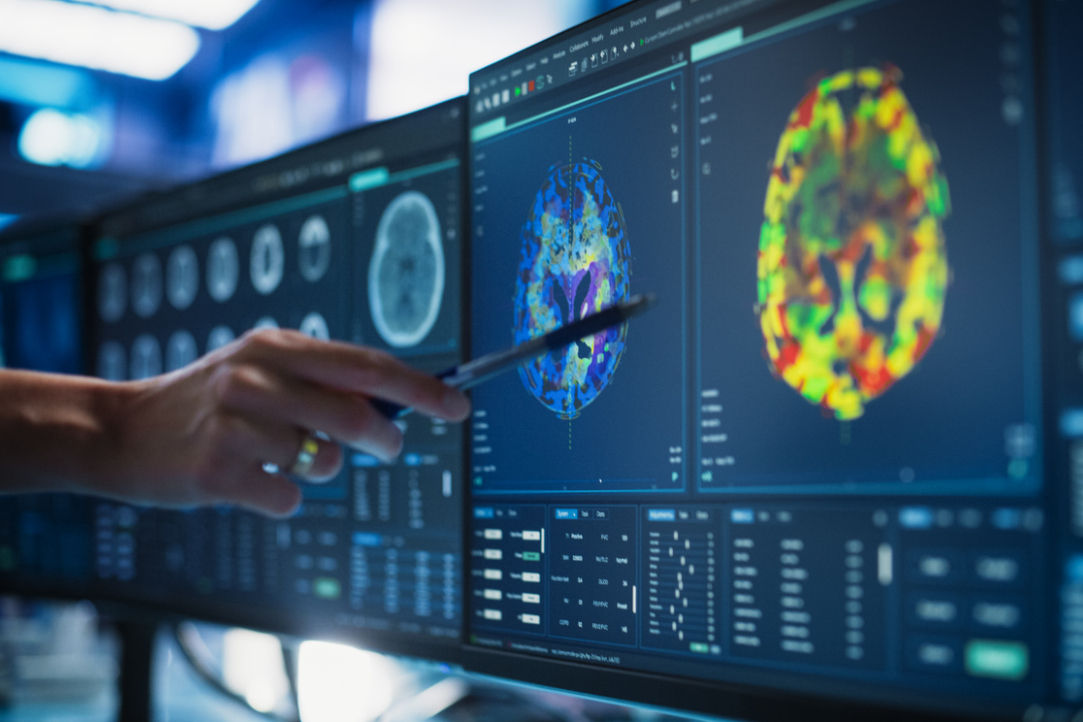Scientists Examine Neurobiology of Pragmatic Reasoning

An international team including scientists from HSE University has investigated the brain's ability to comprehend hidden meanings in spoken messages. Using fMRI, the researchers found that unambiguous meanings activate brain regions involved in decision-making, whereas processing complex and ambiguous utterances engages regions responsible for analysing context and the speaker's intentions. The more complex the task, the greater the interaction between these regions, enabling the brain to decipher the meaning. The study has been published in NeuroImage.
Everyone has likely encountered a situation where the words spoken by their conversation partner did not align with their intended message. We can understand innuendos, irony, and sarcasm, even when the spoken words formally convey the opposite meaning. In cognitive science, this process is known as pragmatic reasoning—the ability to infer meaning from context, even when it is not explicitly expressed.
An international team of scientists conducted a study to uncover how the brain processes such situations. The study participants played a reference game, an experimental method used to investigate how people interpret ambiguous messages. In each trial, participants saw four expressible features and three monsters on the screen—a potato monster, an eggplant monster, and a pear monster. Each monster wore an accessory: a blue hat, a red hat, or a yellow scarf. The speaker sent a message highlighted by a yellow rectangle, such as 'red hat.' Participants had to determine which character was implied, but the clue was not always unambiguous, and the correct answer depended on the context. The experiment had three levels of complexity: simple, complex, and unambiguous, with the latter serving as the baseline condition. There were a total of 96 trials, with 32 trials for each level.
To identify which regions of the brain are involved in the interpretation process, the scientists recorded the participants' brain activity using functional magnetic resonance imaging (fMRI). This neuroimaging method makes it possible to study brain activity in real time. The authors of the paper also developed six computer models to characterise participants' behaviour and the strategies they use to interpret the information.

Their findings reveal that when a participant quickly understood the intended meaning of a phrase and was confident in their answer, the ventromedial prefrontal cortex (vmPFC), involved in decision-making, and the ventral striatum (VS), associated with the feeling of having made the right choice, were active.
However, when the meaning of an utterance was ambiguous, the brain activated other regions: the dorsomedial prefrontal cortex (dmPFC), which analyses the interlocutor's intentions and helps make sense of complex situations; the anterior insula (AI), which responds to uncertainty and tension by contributing to the generation of emotions; and the inferior frontal gyrus (IFG), responsible for language processing. The more complex the task, the more actively these regions interacted, helping the brain correctly interpret the meaning.
The researchers also found that the ability to understand others' thoughts and emotions contributed to successful performance. Participants who performed better exhibited stronger functional connectivity between the prefrontal cortex and the anterior insular cortex, indicating greater flexibility in their reasoning. Previously, pragmatic reasoning was studied within the framework of general models that involve common cognitive mechanisms. However, this study reveals that interpretation strategies can differ among individuals.
'Language comprehension is not just a matter of intelligence or memory. Our brain uses a complex system that integrates language, social cognition, and context analysis,' explains Mario Martinez-Saito, Research Fellow at the HSE International Laboratory of Social Neurobiology. 'The results obtained could also have practical applications. Perhaps, thanks to such research, your voice assistant will finally be able to distinguish between sincere praise and sarcasm.'
See also:
Larger Groups of Students Use AI More Effectively in Learning
Researchers at the Institute of Education and the Faculty of Economic Sciences at HSE University have studied what factors determine the success of student group projects when they are completed with the help of artificial intelligence (AI). Their findings suggest that, in addition to the knowledge level of the team members, the size of the group also plays a significant role—the larger it is, the more efficient the process becomes. The study was published in Innovations in Education and Teaching International.
New Models for Studying Diseases: From Petri Dishes to Organs-on-a-Chip
Biologists from HSE University, in collaboration with researchers from the Kulakov National Medical Research Centre for Obstetrics, Gynecology, and Perinatology, have used advanced microfluidic technologies to study preeclampsia—one of the most dangerous pregnancy complications, posing serious risks to the life and health of both mother and child. In a paper published in BioChip Journal, the researchers review modern cellular models—including advanced placenta-on-a-chip technologies—that offer deeper insights into the mechanisms of the disorder and support the development of effective treatments.
Using Two Cryptocurrencies Enhances Volatility Forecasting
Researchers from the HSE Faculty of Economic Sciences have found that Bitcoin price volatility can be effectively predicted using Ethereum, the second-most popular cryptocurrency. Incorporating Ethereum into a predictive model reduces the forecast error to 23%, outperforming neural networks and other complex algorithms. The article has been published in Applied Econometrics.
Administrative Staff Are Crucial to University Efficiency—But Only in Teaching-Oriented Institutions
An international team of researchers, including scholars from HSE University, has analysed how the number of non-academic staff affects a university’s performance. The study found that the outcome depends on the institution’s profile: in research universities, the share of administrative and support staff has no effect on efficiency, whereas in teaching-oriented universities, there is a positive correlation. The findings have been published in Applied Economics.
Physicists at HSE University Reveal How Vortices Behave in Two-Dimensional Turbulence
Researchers from the Landau Institute for Theoretical Physics of the Russian Academy of Sciences and the HSE University's Faculty of Physics have discovered how external forces affect the behaviour of turbulent flows. The scientists showed that even a small external torque can stabilise the system and extend the lifetime of large vortices. These findings may improve the accuracy of models of atmospheric and oceanic circulation. The paper has been published in Physics of Fluids.
Solvent Instead of Toxic Reagents: Chemists Develop Environmentally Friendly Method for Synthesising Aniline Derivatives
An international team of researchers, including chemists from HSE University and the A.N. Nesmeyanov Institute of Organoelement Compounds of the Russian Academy of Sciences (INEOS RAS), has developed a new method for synthesising aniline derivatives—compounds widely used in the production of medicines, dyes, and electronic materials. Instead of relying on toxic and expensive reagents, they proposed using tetrahydrofuran, which can be derived from renewable raw materials. The reaction was carried out in the presence of readily available cobalt salts and syngas. This approach reduces hazardous waste and simplifies the production process, making it more environmentally friendly. The study has been published in ChemSusChem.
How Colour Affects Pricing: Why Art Collectors Pay More for Blue
Economists from HSE University, St Petersburg State University, and the University of Florida have found which colours in abstract paintings increase their market value. An analysis of thousands of canvases sold at auctions revealed that buyers place a higher value on blue and favour bright, saturated palettes, while showing less appreciation for traditional colour schemes. The article has been published in Information Systems Frontiers.
New Method for Describing Graphene Simplifies Analysis of Nanomaterials
An international team, including scientists from HSE University, has proposed a new mathematical method to analyse the structure of graphene. The scientists demonstrated that the characteristics of a graphene lattice can be represented using a three-step random walk model of a particle. This approach allows the lattice to be described more quickly and without cumbersome calculations. The study has been published in Journal of Physics A: Mathematical and Theoretical.
Scientists Have Modelled Supercapacitor Operation at Molecular and Ionic Level
HSE scientists used supercomputer simulations to study the behaviour of ions and water molecules inside the nanopores of a supercapacitor. The results showed that even a very small amount of water alters the charge distribution inside the nanopores and influences the device’s energy storage capacity. This approach makes it possible to predict how supercapacitors behave under different electrolyte compositions and humidity conditions. The paper has been published in Electrochimica Acta. The study was supported by a grant from the Russian Science Foundation (RSF).
Designing an Accurate Reading Skills Test: Why Parallel Texts are Important in Dyslexia Diagnosis
Researchers from the HSE Centre for Language and Brain have developed a tool for accurately assessing reading skills in adults with reading impairments. It can be used, for instance, before and after sessions with a language therapist. The tool includes two texts that differ in content but are equal in complexity: participants were observed to read them at the same speed, make a similar number of errors, and understand the content to the same degree. Such parallel texts will enable more accurate diagnosis of dyslexia and better monitoring of the effectiveness of interventions aimed at addressing it. The paper has been published in Educational Studies.



